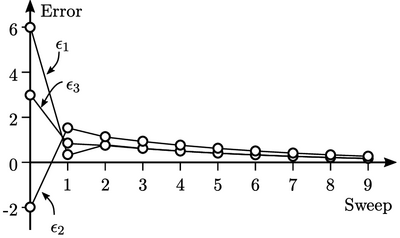5.3 Convergence
The Gauss-Seidel method was demonstrated in Sec. 5.2 using a sample problem, Eq. (5.2 ), that converged to within 0.2% accuracy in 9 solution sweeps. This section discusses the criteria for convergence of a solution.
The easiest explanation of convergence considers
the error  for each equation
for each equation  , defined in Sec. 5.2
. Substituting
, defined in Sec. 5.2
. Substituting  in each term
in Eq. (5.3
), e.g. in Eq. (5.3a
), gives
in each term
in Eq. (5.3
), e.g. in Eq. (5.3a
), gives
 |
(5.5) |
 , Eq. (5.5
) reduces to
, Eq. (5.5
) reduces to
 |
(5.6) |
 is at
least as large as the sum of the terms on the r.h.s., but is
smaller if the signs of
is at
least as large as the sum of the terms on the r.h.s., but is
smaller if the signs of  and
and  are different,
i.e.
are different,
i.e.
 |
(5.7) |
The solution begins with an initial error of
 ,
,
 and
and  . After one sweep the error is
. After one sweep the error is  ,
,  and
and  .
.

The error is quickly distributed evenly, such
that  and
and  are almost identical at sweep 2. The errors continue
to reduce since Eq. (5.7
) and
Eq. (5.8
) guarantee that
no error is greater than the average of the other errors.
are almost identical at sweep 2. The errors continue
to reduce since Eq. (5.7
) and
Eq. (5.8
) guarantee that
no error is greater than the average of the other errors.
Condition for convergence
The behaviour of this problem indicates a convergence condition for the Gauss-Seidel method: the magnitude of the diagonal coefficient in each matrix row must be greater than or equal to the sum of the magnitudes of the other coefficients in the row; in one row at least, the “greater than” condition must hold.
This is known as diagonal dominance, which is a sufficient condition for convergence, described mathematically as
 |
(5.9) |
 ’ condition must be satisfied for at least one
’ condition must be satisfied for at least one
 .
The description of the condition as “sufficient” means that
convergence may occur when the condition is not met.
.
The description of the condition as “sufficient” means that
convergence may occur when the condition is not met.


